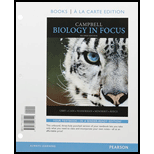
Concept explainers
FOCUS ON INFORMATION
In sexually reproducing species, each individual begins life with DNA inherited from both parent organisms. In a short essay (100-150 words), apply this idea to what occurs when organisms of two species that have homologous chromosomes mate and produce (F1) hybrid offspring. What percentage of the DNA in the F1 hybrids' chromosomes comes from each parent species? As the hybrids mate and produce F2 and later-generation hybrid offspring, describe how recombination and natural selection may affect whether the DNA in hybrid chromosomes is derived from one parent species or the other.
Want to see the full answer?
Check out a sample textbook solution
Chapter 22 Solutions
Campbell Biology in Focus, Books a la Carte Edition; Modified Mastering Biology with Pearson eText - ValuePack Access Card - for Campbell Biology in Focus (2nd Edition)
Additional Science Textbook Solutions
Biology: Life on Earth with Physiology (11th Edition)
Human Physiology: An Integrated Approach (8th Edition)
Anatomy & Physiology
HUMAN ANATOMY
Campbell Essential Biology (7th Edition)
- VISUALIZE Use two different colors to depict the unduplicated chromosomes of species C with larger chromosomes (2n = 8) and species D with slightly smaller chromosomes (2n = 10), and of their F1 hybrid. Is the hybrid likely to be fertile?arrow_forwardconsider the metaphase (mitosis) chromosome spread of the following related animal species. The first meiotic division in the hybrid animal shows a mixture of paired and single chromosomes. Why do you suppose this occurs? Can you suggest a possible relationship between the mixed chromosomes and the observed sterility of the hybrid?arrow_forward. Genomes A, B, and C all have basic chromosomenumbers (x) of nine. These genomes were derivedoriginally from plant species that had diverged from each other sufficiently far back in the evolutionarypast that the chromosomes from one genome can nolonger pair with the chromosomes from any other genome. For plants with the following kinds of euploidchromosome complements, (i) state the number ofchromosomes in the organism; (ii) provide terms thatdescribe the individual’s genetic makeup as accurately as possible; (iii) state whether or not it is likelythat this plant will be fertile, and if so, give the number of chromosomes (n) in the gametes.a. AABBCb. BBBBc. CCCd. BBCCe. ABCf. AABBCCarrow_forward
- Background Info Rainbow trout go through a unique genetic reproductive process. Female eggs are diploid, while male sperm are haploid. In the wild, when the sperm fertilizes an egg, the extra set of chromosomes is kicked out, resulting in a diploid offspring.Triploid trout are produced in the lab to provide sterile fish stock for lakes. Shortly after the eggs are fertilized, scientists place them in a warm water bath to prevent the extra chromosomes from being removed. The result is a triploid fish that cannot reproduce.Rainbow Trout: n = 30 Global warming is an issue affecting many species around the world. Warming has caused the temperatures in lakes and rivers to increase and stay elevated for longer periods of time. Question Select the FOUR numbers that describe the possible effects of global warming on the reproduction of rainbow trout in the wild and on biodiversity. The extra set of chromosomes remains. The extra set of chromosomes is removed. The offspring are diploid (2n).…arrow_forwardNeed help with the diagram The STR DNA marker DS11 is located on the p arm of the chromosome #8 in humans. Molecular analysis has shown that Charlie Chaplin is a heterozygote for the STR marker (genotype DS11A and DS11B) Using this knowledge, provide a diagram of meiosis showing only the movements of chromosome 8 (assume no nondisjunction). Throughout, indicate where the marker may be found (in other words, label the chromosome to show where the STR markers can be found. please only show the chromosomes at interphase, metaphase 1, end of meiosis 1, metaphase 2, and end of meiosis 2.arrow_forwardI need help with b, c, d the choices for c) are haploid, diploid or tetraploid the choices for d) are same chromosome, a pair of homologus chromosomes, or two different chromosomesarrow_forward
- Diploid vs. Haploid: Given 2n = 30a. Haploid (n) number? b. This organism has a total of how many chromosomes? c. How many different pairs of chromosomes does this organismhave?arrow_forwardSketch a series of diagrams showing each of the following, making sure to end each series with haploid cells:(a) How a pair of alleles for a single locus segregate in meiosis(b) How the alleles of two unlinked loci assort independently in meiosis(c) How the alleles of two linked loci undergo genetic recombinationarrow_forwardAll of the above 8. Which is the correct description of the human chromosome number? * O2n =23 (where n=23, the number of different numbered human chromosomes) O2n = 46 (where n=23, the number of different numbered human chromosomes) O 4n = 23 (where n=23, the number of different numbered human chromosomes) O4n = 46 (where n=23, the number of different numbered human chromosomes) Any comments please use this space (e.g. to clarify an answer or point out w issues on questions, etc.)arrow_forward
- Why is meiosis useful? Select all that apply 1. I produces genetically variable offspring 2. it maintains the chromosome number between generations 3. it reduces the frequency of mutations 4. it provides an alternative route to cell division for cells that fail to complete mitosis 5. It does not require proteinsarrow_forwardConstruct a chromosome map from the following charts showing crossover frequencies for linkage groups on autosomes. (this one is tricky due to the unusual recombinations Gene Combinations Recombination Frequency y/w 2.2 v/m 3.0 v/r 26.6 v/w 30.0 v/y 32.2 w/m 33.0 y/m 35.2 w/r 56.6arrow_forwardIn what 3 ways does sexual reproduction result in genetic recombination?arrow_forward
 Biology: The Dynamic Science (MindTap Course List)BiologyISBN:9781305389892Author:Peter J. Russell, Paul E. Hertz, Beverly McMillanPublisher:Cengage Learning
Biology: The Dynamic Science (MindTap Course List)BiologyISBN:9781305389892Author:Peter J. Russell, Paul E. Hertz, Beverly McMillanPublisher:Cengage Learning Biology (MindTap Course List)BiologyISBN:9781337392938Author:Eldra Solomon, Charles Martin, Diana W. Martin, Linda R. BergPublisher:Cengage Learning
Biology (MindTap Course List)BiologyISBN:9781337392938Author:Eldra Solomon, Charles Martin, Diana W. Martin, Linda R. BergPublisher:Cengage Learning

